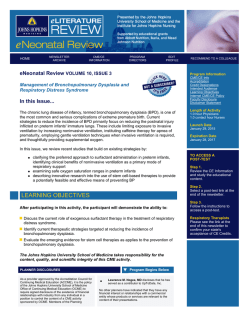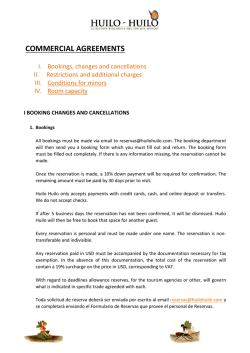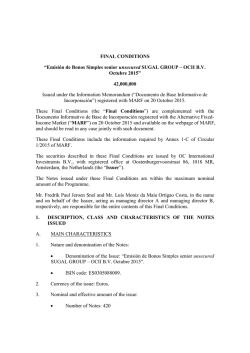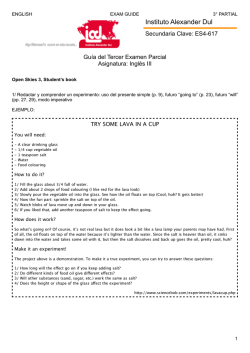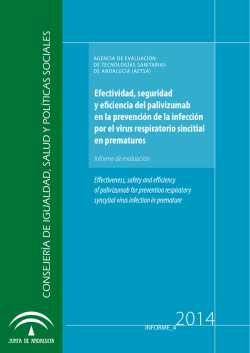
Elective extubation during skin-to-skin contact in the extremely
Documento descargado de http://www.analesdepediatria.org el 09/05/2016. Copia para uso personal, se prohíbe la transmisión de este documento por cualquier medio o formato. SCIENTIFIC LETTERS Clinical case 2 Girl aged 19 months referred to the paediatrics clinic for failure to thrive between 15 and 18 months of life. The parents were not consanguineous, were originally from Bangladesh, and had no relevant medical history. The patient had a varied diet adequate for her age, and she continued to breastfeed on demand. Her psychomotor development was normal. Physical examination revealed a weight of 9.045 kg (3rd---10th percentile), height of 77 cm (3rd---10th percentile), Waterlow height-for-age of 95%, weight-for-height z-score of −0.73 SDS (WHO standards), and marked abdominal swelling with hepatomegaly of 8 cm. The abdominal ultrasound scan evinced a uniform hepatomegaly. The salient findings of the chemistry panel were AST, 1858 U/L; ALT, 1029 U/L; glucose, 56 mg/dL; and triglycerides, 257 mg/dL. In the glucagon test, the glucose level before administration of glucagon was 28 mg/dL, and at 30 min it was 40 mg/dL without hyperlactacidaemia. Genetic testing was requested for suspected glycogen storage disease, which identified amylo-1,6-glucosidase deficiency, leading to diagnosis of type IIIa glycogen storage disease. She required continuous nocturnal gastric feeding for a period of two weeks. Subsequently, thanks to extensive family involvement, the patient achieved adequate metabolic control with feedings at 4 h intervals in the daytime, and two cornstarch feedings during the night. The presence of progressive abdominal swelling in an infant requires ruling out hepatomegaly, among other conditions. In some cases, considerable liver enlargement that can reach as far as the iliac crest is difficult to feel with palpation and may go unnoticed,2 as described in the two cases. A differential diagnosis of the multiple aetiologies of hepatomegaly can be performed by history taking, physical examination and diagnostic tests.2 In the cases presented here, in addition to hepatomegaly and the marked abdominal swelling, the failure to thrive and the presence of hypertransaminasaemia, hyperlipidaemia and hypoglycaemia with abnormal results in the glucagon test led us to suspect a diagnosis of glycogen storage disease.3 Glycogen storage disease type III is caused by a deficiency of amylo-1,6-glucosidase, also known as glycogen debranching enzyme, an enzyme involved in glycogenolysis whose deficiency leads to accumulation of limit dextrins. In 85% of cases, this deficiency affects the liver and muscle tissues Elective extubation during skin-to-skin contact in the extremely premature newborn夽 Extubación electiva durante el contacto piel con piel en el prematuro extremo 夽 Please cite this article as: Camba F, Céspedes MC, Jordán R, Gargallo E, Perapoch J. Extubación electiva durante el contacto piel con piel en el prematuro extremo. An Pediatr (Barc). 2016;84:289291. 289 (subtype IIIa).4 Glycogen storage disease type IX results from a defect in the activation of phosphorylase kinase, which is also involved in glycogenolysis. Different mutations may occur in the genes of each of the subunits that compose the enzyme (␣, ß, ␥, ␦) with variable presence in different tissues. X-linked glycogen storage disease type IXb (XLG) is the most frequent form and only involves the liver.5 The main goal of treatment is to prevent hypoglycaemia. This requires avoiding prolonged fasting periods by the frequent intake of slow-release carbohydrates throughout the day, and in some cases, especially in infants, nocturnal gastric feedings.6 References 1. Cabral A. Glucogenosis. In: Sanjurjo P, Baldellou A, editors. Diagnóstico y tratamiento de las enfermedades metabólicas hereditarias. Madrid: Ergon; 2001. p. 161---72. 2. Wolf AD, Lavine JE. Hepatomegaly in neonates and children. Pediatr Rev. 2000;21:303---10. 3. Wolfsdorf JI, Weinstein DA. Glycogen storage diseases. Rev Endocrinol Metab Disord. 2003;4:95---102. 4. Hershkovitz E, Forschner I, Mandel H, Spiegel R, Lerman-Sagie T, Anikster Y, et al. Glycogen storage disease type III in Israel: presentation and long-term outcome. Pediatr Endocrinol Rev. 2014;11:318---23. 5. Beauchamp NJ, Dalton A, Ramaswami U, Niinikoski H, Mention K, Kenny P, et al. Glycogen storage disease type IX: high variability in clinical phenotype. Mol Genet Metab. 2007;92:88---99. 6. Smit GPA, Rake JP, Akman HO, DiMauro S. The glycogen storage diseases and related disorders. In: Fernandes J, Saudubray JM, Walter JH, editors. Inborn metabolic diseases. 4th ed. Berlín: Springer; 2006. p. 101---20. R. Sierra-Poyatos a , T. Gavela-Pérez b , M. Blanco-Rodríguez b , L. Soriano-Guillén b,∗ a Servicio de Endocrinología y Nutrición, Instituto de Investigación Sanitaria Fundación Jiménez Díaz, Universidad Autónoma de Madrid, Madrid, Spain b Servicio de Pediatría, Instituto de Investigación Sanitaria Fundación Jiménez Díaz, Universidad Autónoma de Madrid, Madrid, Spain Corresponding author. E-mail addresses: [email protected], [email protected] (L. Soriano-Guillén). ∗ Dear Editor: As evidence has been growing on the benefits of kangaroo care,1 the practice of skin-to-skin contact has spread through neonatal units and is being implemented in more patients, including extremely preterm newborns.2 Cardiorespiratory parameters are more stable during skin-to-skin contact.3,4 Studies in extremely preterm newborns have demonstrated the safety of skin-to-skin contact during mechanical ventilation,5 and one study conducted in term newborns that had undergone surgery found greater stability in cardiorespiratory parameters following extubation in infants that had been put in skin-to-skin contact with their parents.6 Documento descargado de http://www.analesdepediatria.org el 09/05/2016. Copia para uso personal, se prohíbe la transmisión de este documento por cualquier medio o formato. 290 SCIENTIFIC LETTERS Table 1 Characteristics of preterm infants extubated during skin-to-skin contact. Patient Gestational age Birth weight (g) Sex CRIB II Previous extubation attempts Days of life Postmenstrual age Weight (g) on day of extubation Extubation failure 1 2 3 4 5 6 7 8 9 10 11 12 13 14 252/7 256/7 253/7 242/7 236/7 243/7 251/7 24 246/7 265/7 245/7 27 26 246/7 760 570 710 650 610 720 630 730 780 850 680 720 600 720 M M F M F M F M M M M F M M 15 15 14 15 15 16 14 17 16 10 14 13 13 15 0 1 1 3 0 0 1 0 0 1 1 1 2 0 41 43 21 46 14 41 36 23 45 26 27 38 29 26 311/7 32 283/7 306/7 256/7 302/7 302/7 272/7 312/7 303/7 284/7 323/7 301/7 284/7 1050 920 750 1050 640 1030 930 900 1430 1220 940 1280 910 830 No No No No No No No No Yes (croup) No No No No Yes (hypoxia) Since the kangaroo care approach facilitates physiological stability, we hypothesised that infants may tolerate extubation better during skin-to-skin contact with their parents compared to conventional extubation in the incubator. We developed a procedure for extubation during kangaroo care, and later performed a retrospective analysis of patients born preterm at less than 28 weeks’ gestational age that were electively extubated during skin-to-skin contact with their parents. The procedure for extubation during skin-to-skin contact was based on the recommendations for the implementation of kangaroo care in mechanically ventilated infants,5 adding elements concerning extubation. The procedure consisted of: controlling environmental stimuli (noise, lighting) during the entire process, transfer from incubator to skin-to-skin contact, preparation of all the necessary material and placement of the CPAP bonnet, skin-to-skin contact for as long as needed to attain physiological stability, followed by extubation and connection to CPAP. The clinical assessment and monitoring were performed as they would have if extubation had taken place in the incubator, and the health care staff was prepared to transfer the patient back to the incubator in case of extubation failure, which was defined as inability to sustain adequate spontaneous ventilation and/or oxygenation. The parents had been informed about the procedure and given consent. We collected the data from the medical records of the patients, and analysed them retrospectively. A total of 14 newborns were extubated during skin-to-skin contact in our unit between 2008 and 2012. Table 1 shows the characteristics of the patients. Their gestational ages ranged from 236/7 to 270/7 weeks, and their birth weights from 570 to 850 g. The mean chronological age at the time of extubation was 32 days (14---46), the postmenstrual age ranged between 25 and 32 weeks, and the weight at the time of extubation ranged between 640 and 1430 g. All the neonates had been put in skin-to-skin contact with their parents before, and half of them had undergone at least one failed extubation attempt in the incubator. Extubation was successful in 12 of the 14 neonates. The reason for extubation failure was croup in one neonate and hypoxia in the other. In these two cases, the patients were transferred back to their incubators and reintubated without complications. No complications developed in association with the procedure, and parents expressed a high level of satisfaction. One of the benefits of skin-to-skin contact is cardiorespiratory stability, even in recently extubated neonates. Thus, kangaroo-care extubation could be well tolerated, as our case series seems to suggest. The procedure is no more complex than skin-to-skin contact in ventilated preterm newborns. As for extubation itself, the sole difference compared to conventional practice is the placement of the child. The incorporation of family-centred care involves increased parental participation in care, which could include extubation during skin-to-skin contact. A high degree of cohesion between parents, the nursing staff and the neonatologist is essential when performing this procedure. Some of the limitations of the study are the absence of a control group and its retrospective design. Furthermore, while parents did express high satisfaction with the method, we did not formally analyse its emotional impact. In our experience, elective extubation during skin-to-skin contact in extremely preterm infants is a safe practice that is not associated to complications outside of those expected in extubation performed in the incubator, and could contribute to increased respiratory stability. Considering the limitations of this study, further studies should be conducted to demonstrate the safety and benefits of this method before recommending it, as well as research on its emotional impact on the parents. Documento descargado de http://www.analesdepediatria.org el 09/05/2016. Copia para uso personal, se prohíbe la transmisión de este documento por cualquier medio o formato. SCIENTIFIC LETTERS References 1. Conde-Agudelo A, Belizán JM, Díaz-Rossello J. Kangaroo mother care to reduce morbidity and mortality in low birthweight infants. Cochrane Database Syst Rev. 2011;2:CD002771. 2. Maastrup R, Greisen G. Extremely preterm infants tolerate skinto-skin contact during the first weeks of life. Acta Paediatr. 2010;99:1145---9. 3. Fohe K, Kropf S, Avenarius S. Skin-to-skin contact improves gas exchange in premature infants. J Perinatol. 2000;5: 311---5. 4. Ludington-Hoe SM, Anderson GC, Swinth JY, Thompson C, Hadeed AJ. Randomized controlled trial of kangaroo care: cardiorespiratory and thermal effects on healthy preterm infants. Neonatal Netw. 2004;23:39---48. Leucoencephalopathy with brain stem and spinal cord involvement and lactate elevation: Report of two new cases夽 Leucoencefalopatía con afectación de troncoencéfalo y médula espinal y elevación de lactato: presentación de 2 nuevos casos Dear Editor: Leucoencephalopathy with brain stem and spinal cord involvement and lactate elevation is a rare disease that affects the white matter of the brain of which fewer than a hundred cases have been described. The onset of symptoms usually occurs during childhood or adolescence and is characterised by slowly progressing cerebellar ataxia, spasticity and dysfunction of the dorsal column of the spinal cord. Its diagnosis is based on the abnormalities found in magnetic resonance imaging (MRI) and spectroscopy. It follows a pattern of autosomal recessive inheritance and caused by mutations in the DARS2 gene. We present the cases of two female twins aged 14 months, born preterm at 32 weeks’ gestation to consanguineous parents, and referred for evaluation due to failure to thrive. They were followed up in the clinic, exhibiting mild psychomotor delay at age 9 months. At 14 months they were admitted for evaluation of severe malnutrition. The neurological assessment revealed psychomotor regression with absence of sitting and turning, irregular eye focusing and tracking, and little interest in objects. A metabolic and nutritional screening was performed, revealing a mild elevation of lactate in blood. The findings of brain and spinal cord MRI were compatible with severe, uniform diffuse involvement of the periventricular, centrum semiovale, 夽 Please cite this article as: Navarro Vázquez I, Maestre Martínez L, Lozano Setién E, Menor Serrano F. Leucoencefalopatía con afectación de troncoencéfalo y médula espinal y elevación de lactato: presentación de 2 nuevos casos. An Pediatr (Barc). 2016;84:291---293. 291 5. Ludington-Hoe SM, Ferreira C, Swinth J, Ceccardi JJ. Safe criteria and procedure for kangaroo care with intubated preterm infants. J Obstet Gynecol Neonatal Nurs. 2003;32:579---88. 6. Gazzolo D, Masetti P, Meli M. Kangaroo care improves postextubation cardiorespiratory parameters in infants after open heart surgery. Acta Paediatr. 2000;89:728---9. Fátima Camba ∗ , María Concepción Céspedes, Raquel Jordán, Estrella Gargallo, Josep Perapoch Servicio de Neonatos, Hospital Universitario Vall d’Hebron, Barcelona, Spain ∗ Corresponding author. E-mail address: [email protected] (F. Camba). and cerebellar peduncle white matter. There was involvement of the posterior and anterior regions of the corpus callosum, the corticospinal tracts from the posterior limb of the internal capsule through the brain stem to the lateral corticospinal tracts in the spinal cord and of the ascending tracts from the dorsal columns of the cervical spinal cord and medial lemniscus of the brain stem to the thalamus and corona radiata (Figs. 1 and 2). We performed a magnetic resonance spectroscopic imaging (MRSI) scan that revealed a decreased N-acetyl aspartate/creatine ratio and lactate elevation. The disease progressed slowly in both twins, with gradual neurological deterioration and recurrent respiratory infections leading to their death at age 2 years. The leucoencephalopathies comprehend a heterogeneous group of diseases that primarily affect the white matter of the brain. In 2003, van der Knaap et al. were the first to describe a novel entity, LBS-L (Leukoencephalopathy with Brainstem and Spinal cord involvement and increased Lactate), which exhibited a pattern of autosomal recessive inheritance.1 In most of the described cases, the symptoms start between early childhood and adolescence, and progress gradually. The main clinical features are slowly progressing cerebellar ataxia, tremors, muscle weakness and spasticity most prominent in the lower limbs, with mild or absent cognitive deficits.1---3 The disease progresses slowly, leading to walking disability and wheelchair dependency over the years. The phenotypic spectrum of the disease is very broad, ranging from oligosymptomatic cases, usually with onset in adulthood, to cases of early onset and rapid and fatal progression.4 Magnetic resonance imaging shows abnormal signal intensity at the level of the periventricular and deep white matter, selective involvement of cerebellar connections, and involvement of the entire length of the pyramidal and ascending tracts to the spinal cord and the intraparenchymal trajectories of the trigeminal nerve.5 The MRSI usually detects lactate elevation. These MRI abnormalities, along with the abnormal elevation of lactate in white matter found by MRSI, are considered characteristic of the disease.1---4 The diagnosis is confirmed by genetic testing. LBS-L is an autosomal recessive disease caused by mutations in the DARS2 gene in chromosome 1, which encodes mitochondrial aspartyltRNA synthetase.6 We did not perform genetic testing in
© Copyright 2024
